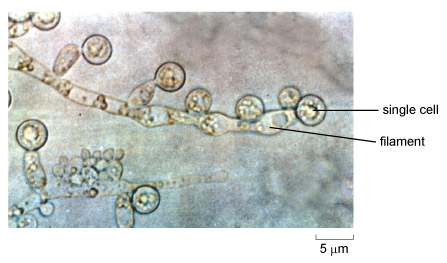3.7 Fungal pathogens
You are probably most familiar with large edible fungi (mushrooms) and the single-celled yeasts used in making bread and beer, but over 300 fungal pathogens cause infectious diseases in humans. They are rarely fatal, except in people whose immune system cannot protect them from infection. Fungal cells in the soil can infect humans through breaks in the skin, but they can also form ‘spores’ encased in a rigid capsule, which can easily become airborne and cause respiratory diseases if inhaled.
Among the most common fungal infections in humans are ringworm, athlete’s foot and thrush. Candida albicans, which causes thrush, exists in two forms – as single-celled yeasts (measuring 3–5 micrometres) and as multicellular filaments which can be several millimetres in length (Figure 12). Thrush is characterised by inflammation, especially in the mouth, and also in the vagina where the infection causes intense itching.

